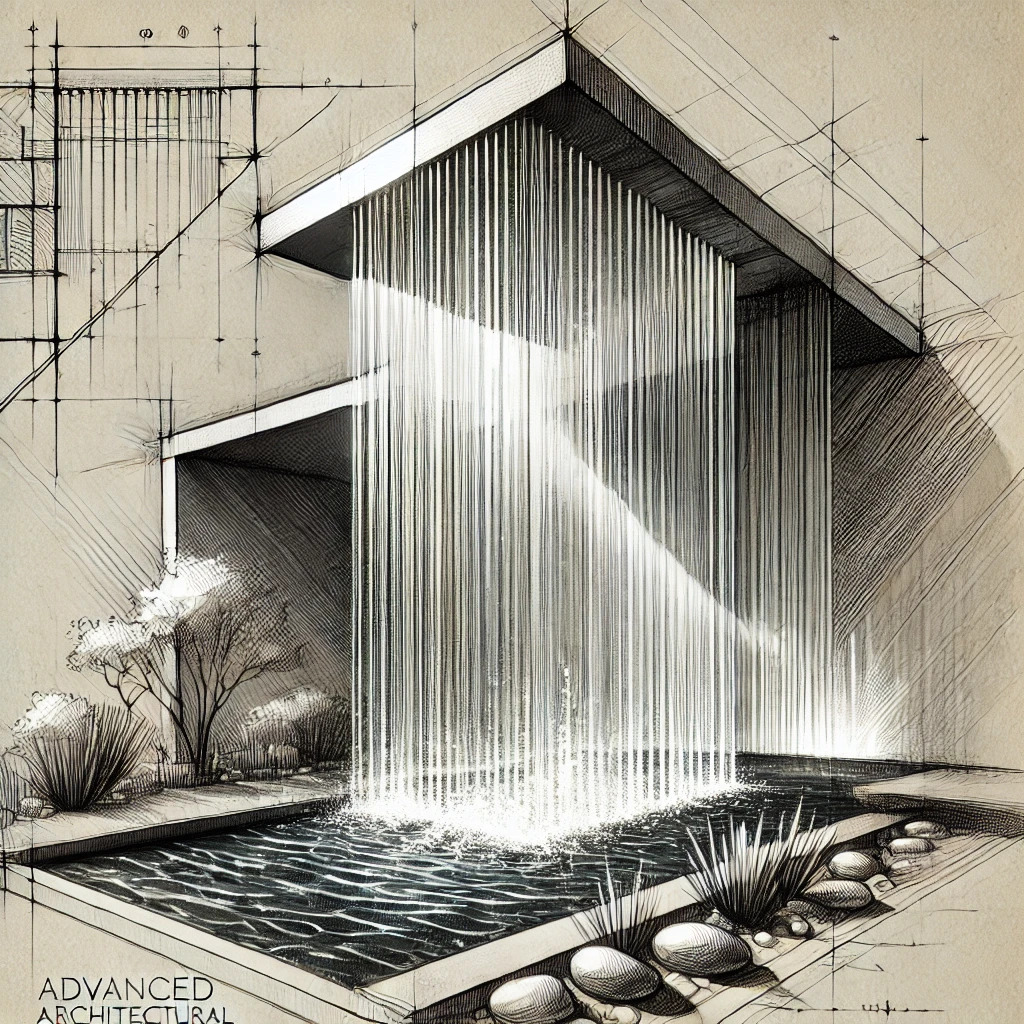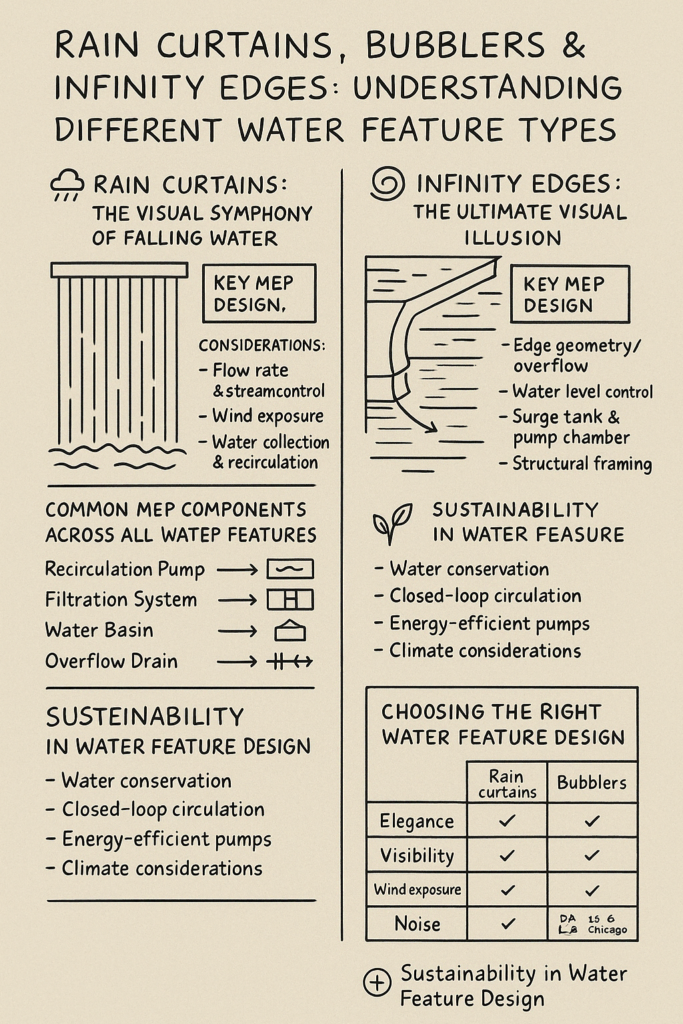
Rain Curtains & Waterfalls: Understanding Different Water Feature Types
In today’s landscape and architectural environments, water features are no longer just decorative—they are statements of elegance, symbols of tranquillity, and focal points in residential and commercial spaces. Among the most refined elements are rain curtains and waterfalls, each delivering unique experiences of motion, sound, and visual appeal.
At Evergreen Adcon, we design and deliver these features with precision engineering and the spirit of design, ensuring both beauty and operational excellence, water efficiency, and long-term reliability.
This article explores rain curtains and waterfalls, including design principles, hydraulic performance, and practical assumptions used in real-world projects.
🌧️ Section 1: What Are Rain Curtains and Waterfalls?
▪️ Rain Curtains
Rain curtains are vertical streams or fine threads of water that fall uniformly from a linear overhead pipe or nozzle system. They’re often used in:
- Hotel lobbies
- Courtyard entrances
- Glass partitions
- Indoor water walls
The goal is to create a laminar sheet of rain, where each droplet behaves like a clean line of glass—calm, rhythmic, and soundless.
▪️ Waterfalls
Architectural waterfalls are broader systems where water flows over a ledge, scupper, or stepped formation. They can be designed to:
- Flow in smooth laminar sheets (e.g., hotel backdrops or villa façades)
- Cascade over rock formations for a natural look
- Fall into reflecting pools, rills, or streams
🧠 Section 2: The Purpose of MEP Design in Water Features
Whether it’s a small indoor feature or a large urban installation, MEP design is critical. It defines the:
- Flow characteristics
- Pump and pipe selection
- Water treatment needs
- Electrical and safety controls
- Automation and control systems
Designing a rain curtain or waterfall without proper hydraulic planning can result in uneven flow, splashing, noise, or even system failure due to pump overload or air-locking.
💡 Section 3: Real-World Engineering Assumptions for Rain Curtains
🔹 Assumption #1: Uniform Flow Requires Equal Pressure
For a 3-meter-wide rain curtain with 80 evenly spaced nozzles, we ensure:
- Each nozzle receives equal water pressure
- The difference in pressure across the header is no more than 10%
- A balancing manifold or flow equalizer is installed to compensate for the pressure drop along the pipe
🔹 Assumption #2: Ideal Velocity for Clear Rainfall
To maintain a smooth, laminar fall, the water velocity at each outlet should not be too high (which causes breakage and mist) or too low (which causes dribble).
We typically aim for:
- 1.0–1.5 meters/second water velocity at nozzle exit
- A drop height of 1.8 to 3.5 meters for the visual effect
If the height exceeds 3.5 meters, wind influence and stream breakup need to be controlled with anti-drift zones or wind-sensor-based auto shutoff.
🔹 Assumption #3: Nozzle Design
We use:
- Precision-machined brass or stainless steel nozzles with diameters between 4 mm to 6 mm
- Spacing of 40–60 mm between nozzles
- Inline filtration before the header to prevent clogging
🔹 Assumption #4: Recirculation Rate and Pump Sizing
For a medium-sized rain curtain:
- Total flow is between 100–300 LPM (liters per minute)
- Pump is sized for a working head of 6–8 meters
- Water is collected in a sump or pebble bed basin and recirculated
A Variable Frequency Drive (VFD) is often recommended to control the start-up and flow variations.
🌊 Section 4: Design Considerations for Waterfalls
🔹 Assumption #1: Flow Depends on Edge Length and Effect Type
For a clean, curtain-like waterfall (over a rectangular weir):
- We need 200–600 LPM per meter length
- The flow should form a continuous sheet, not droplets or rivulets
For rock-style cascades or multiple ledges:
- Flow varies more—often 800–1200 LPM in total depending on surface texture and visual volume
🔹 Assumption #2: Water Depth Over the Spill Edge
A minimum depth of 20–30 mm of water above the spill edge is needed to produce a smooth fall.
The edge should be:
- Polished stainless steel or cast scupper
- Slightly beveled to reduce turbulence
- Designed to be level within 2 mm across the length
🔹 Assumption #3: Receiving Pool Volume
The plunge pool or lower basin must:
- Hold at least 1.5x the volume of water in transit
- Be free of standing foam and designed to minimize splash
- Include sub-surface suction inlets, debris strainers, and calming zones
🔹 Assumption #4: Surge and Splash Allowance
We allow for:
- 10–15% extra capacity in the system to manage surge
- Overflow channels or auto top-up systems to maintain level
- Treated non-potable or greywater for replenishment in sustainable projects
🧰 Section 5: Common Materials Used
| System Component | Recommended Material |
| Header Pipe | SS 316L, HDPE PN16, or uPVC SCH80 |
| Nozzles | SS 304/316 or precision brass |
| Basin or Reflector | Concrete + waterstop liner or SS tray |
| Lighting | IP68-rated RGB submersible LEDs |
| Control Valves | Motorized butterfly or solenoid |
| Pumps | Submersible or vertical inline VFD |
🔌 Section 6: Automation & Control Logic
For modern projects, we integrate smart automation:
- Rain Curtain Controls:
- Timer-based activation (e.g., 7 AM – 10 PM)
- Wind sensor auto shutdown during high wind speeds (>15 km/h)
- Dry-run and low-level protection for pump
- DMX lighting synchronization with the rhythm
- Waterfall Controls:
- Scheduled circulation with energy optimisation
- Temperature and level monitoring
- Overflow return for splash collection
- UV or ozone disinfection modules
📊 Section 7: Water Quality and Maintenance
To maintain clarity and hygiene:
- Install sand or cartridge filtration units
- Add UV sterilisation for biological control
- Use float sensors to trigger a water top-up
- Conduct weekly inspections for nozzle blockages
- Apply anti-algae treatment monthly (especially outdoors)
For outdoor waterfalls:
- Dust and pollen must be filtered daily to prevent cloudiness
- Periodic flushing is designed into the system via drain ports
🧪 Section 8: Case Study Snapshots
🏢 Hotel Rain Curtain – Dubai
- Width: 3.6 m
- Height: 3 m
- Flow: 260 LPM via 96 nozzles
- System: SS manifold + VFD pump + overflow basin
- Controls: Wind shutoff + DMX RGB LED + PLC timer
🏡 Villa Waterfall Wall – Abu Dhabi
- Length: 2.4 m scupper edge
- Flow: 420 LPM
- Basin volume: 1000 liters
- System: Sheet waterfall with return filtration loop
- Lighting: Warm white LED strip + proximity control
🏁 Conclusion
Rain curtains and waterfalls add more than just luxury—they define ambience, evoke calm, and introduce movement and sound into static spaces. But behind their simple beauty lies a world of precise planning, hydraulic balance, material engineering, and operational logic.
At Evergreen Adcon, we combine artistic intent with technical rigor, ensuring that your water feature not only looks spectacular but performs seamlessly for years.



